The Principle of Relativity |
|
The Principle of Relativity (Galileo)
|
From his Dialogue Concerning the Two Chief World Systems, Galileo wrote:
...have the ship proceed with any speed you like, so long as
the motion is uniform and not fluctuating this way and that.
You will discover not the least change in all the effects
named, nor could you tell from any of them whether the ship
was moving or standing still.
Galileo's Principle of Relativity
The mechanical laws of physics are the same for every inertial observer.
By observing the outcome of mechanical experiments,
one cannot distinguish a state of rest from a state of constant velocity.
|
|
The Principle of Relativity (Einstein)
|
From his Relativity
The Special and General Theory, Einstein wrote:
As long as one was convinced that all natural phenomena were
capable of representation with the help of classical
mechanics, there was no need to doubt the validity of this
principle of relativity. But in view of the more recent
development of electrodynamics and optics it became more and
more evident that classical mechanics affords an
insufficient foundation for the physical description of all
natural phenomena. At this juncture the question of the
validity of the principle of relativity became ripe for
discussion, and it did not appear impossible that the answer
to this question might be in the negative.
Nevertheless, there are two general facts which at the
outset speak very much in favour of the validity of the
principle of relativity. Even though classical mechanics
does not supply us with a sufficiently broad basis for the
theoretical presentation of all physical phenomena, still we
must grant it a considerable measure of “truth,” since it
supplies us with the actual motions of the heavenly bodies
with a delicacy of detail little short of wonderful. The
principle of relativity must therefore apply with great
accuracy in the domain of mechanics. But that a principle of
such broad generality should hold with such exactness in one
domain of phenomena, and yet should be invalid for another,
is a priori not very probable.
Einstein's Principle of Relativity
ALL OF THE LAWS OF PHYSICS are the same for every inertial observer.
By observing the outcome of any experiment (mechanical, electromagnetic, optical---or any physical law whatsoever),
one cannot distinguish a state of rest from a state of constant velocity.
|
Light travels at 3.00 x 108 m/s |
|
A light ray travels with speed c=3.00 x 108 m/s,
independently of the motion of its source.
On a
spacetime-diagram
with the axes calibrated as above, a light-ray [shown in yellow]
always makes at angle of 45o with the time-axis
[which is, by convention, oriented vertically upward].
When a flash of light is emitted by a source
light-rays
spread out isotropically in space,
tracing out a cone on a spacetime-diagram.
This cone is called the "[future] light-cone of the emission event".
The light-cone depends only on the emission event.
It does not depend on the motion of the source of the light.
The source [modeled as a point-particle in space]
traces out a curve (called its "worldline") on a spacetime-diagram.
The green source is at rest, and
the red source is in motion (with v=0.5c).
|
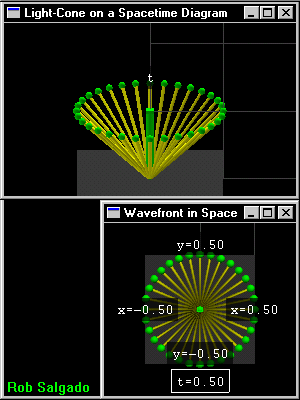
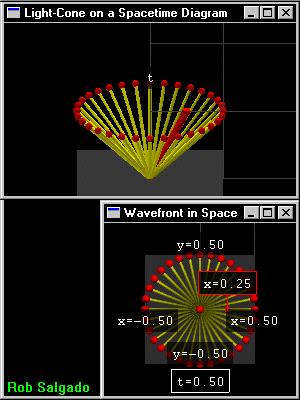
|
On this page,
- "spatial-distances" are measured in units of (meters)
- "time-intervals" are measured in units of
(meters/c)
=1/(3x108) seconds
=(10/3) nanoseconds
- in these units, the "speed" is measured in units of
(meters)/(meters/c)=(c).
All numerical measurements (x, y, t)
that we report
are measurements in the rest-frame.
All spacetime-diagrams that we display
are diagrams drawn by the rest-frame.
(Occasionally, we will draw
two widely-separated parts
of the same spacetime-diagram.)
|
|
The Light Clock [at Rest] |
|
With a pair of mirrors and a light source, we can construct a simple clock--called
the "light clock".
When we place a mirror at a distance L away from the source,
a light ray travels at the speed of light
for a time t=(L/c) to get to that distant mirror.
Then, upon reflection, a light ray travels at the speed of light
for an additional time t=(L/c) to get back to the source.
The duration of the round-trip is T=(2L/c). This defines one "tick" of this clock.
In these diagrams, we have chosen
L=(0.5 m).
|
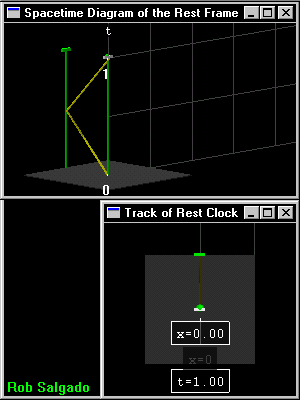
|
The Light Clock [in Uniform Motion] |
|
Suppose we have an identically constructed clock (the red clock ),
which has a uniform velocity of v=0.5c along the x-direction.
What is the duration of one tick of this moving clock?
We measure the duration of that red tick to be longer
than the duration of our our green tick.
Why?
Because [to us] the moving mirror
is moving away from the source, the light ray (traveling at the speed of light)
that reaches that moving mirror must travel a
longer distance for a longer duration.
This is time-dilation.
Let us refer to this type of light clock as a
"transverse light-clock".
Transverse means that the light clock is oriented perpendicular to the direction
of relative-motion.
(In the next section, we will also use a light clock
that is oriented parallel to the direction of relative-motion.
We refer to this type of clock as a
"longitudinal light-clock".)
|
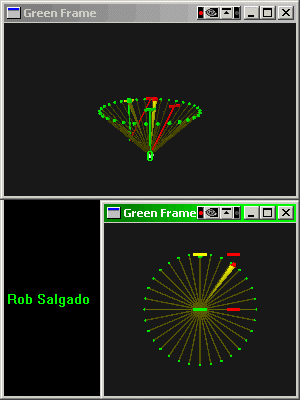
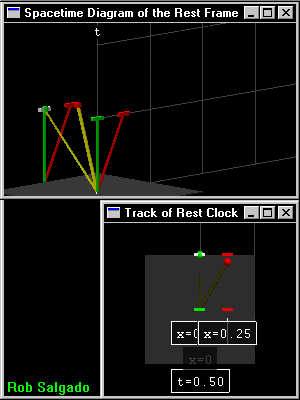
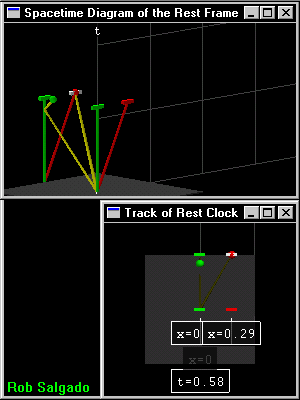
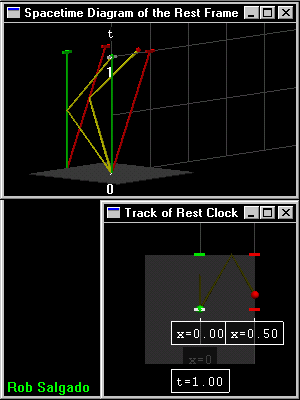
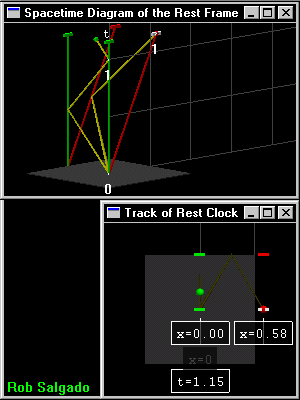
|
A Michelson-Morley apparatus [at Rest] |
|
When we arrange two identical light clocks perpendicular to each other,
we obtain [what we will call] a "simplified Michelson-Morley apparatus".
Observe:
Light rays, emitted by the source at a common event
then reflected back by the equidistant mirrors,
are received by the source at the same reception event.
[To us,]
the orientation of the two light clocks does not matter here.
[To us,]
the reflections on our distant green mirrors
occurred at the same value of t. Let us refer to this as
our "half-tick".
|
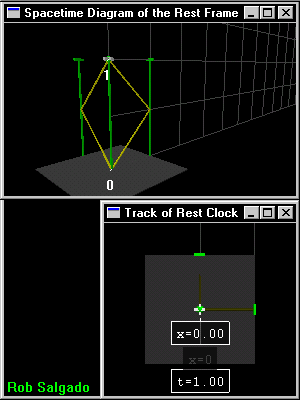
|
A Michelson-Morley apparatus [in Uniform Motion]
(attempt #1; in conflict with the Principle of Relativity) |
|
Suppose we have an identically constructed Michelson-Morley apparatus
(the red set of clocks), which has a uniform velocity of v=0.5c along the x-direction.
We already know that the light ray (traveling at the speed of light)
must travel a longer distance for a longer duration
to reach the "transverse mirror".
In fact, the light ray (traveling at the speed of light)
that reaches the "longitudinal mirror"
moving away from the source must travel an
even longer distance for a even longer duration.
[It had a headstart along the direction of motion!]
Thus, the outgoing light ray reaches the
moving longitudinal mirror after
the light ray reaches the moving transverse mirror.
Upon reflection, the return trip to the moving source
doesn't take as long since the moving source is
moving toward the incoming light ray.
Although these are interesting observations
(which we will deal with later),
a more serious observation is this:
Note carefully that the reflections are not received at the same event.
The longitudinal reflection is received first, followed by the transverse reflection.
|
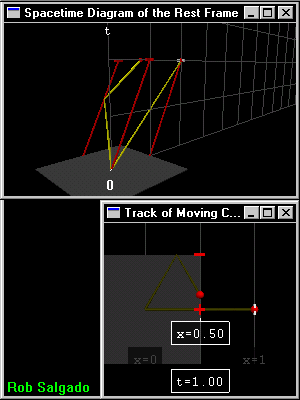
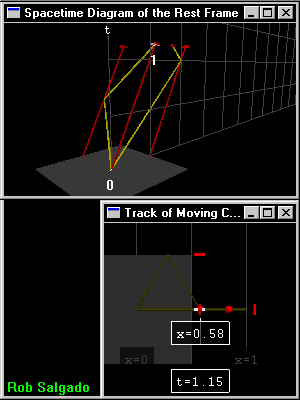
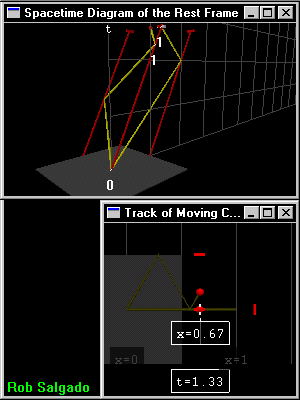
|
|
It appears that the red clock in motion
can now distinguish itself from the green clock at rest.
This situation, however, violates the principle of relativity!
The red clock in motion
does not receive its reflections simultaneously.
In fact, the time-difference between the two receptions
can be used to calculate the velocity of the moving red clock.
The experiment of Michelson and Morley
effectively tried to measure this time difference...
but they always measured zero.
(experimental data)
Apparently, there is something wrong with
this proposed model of the moving clock.
|
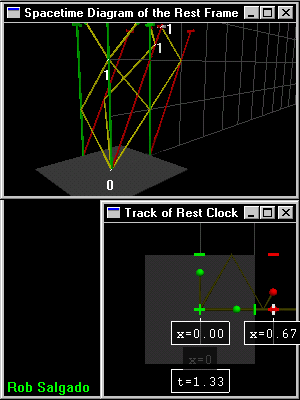
|
A Michelson-Morley apparatus [in Uniform Motion]
(attempt #2; in accordance with the Principle of Relativity) |
|
To satisfy the requirement that the two receptions occur
at the same event for the red clock in motion, it can be shown
that the position of the moving longitudinal mirror
must be shorter than L.
This is length-contraction.
|
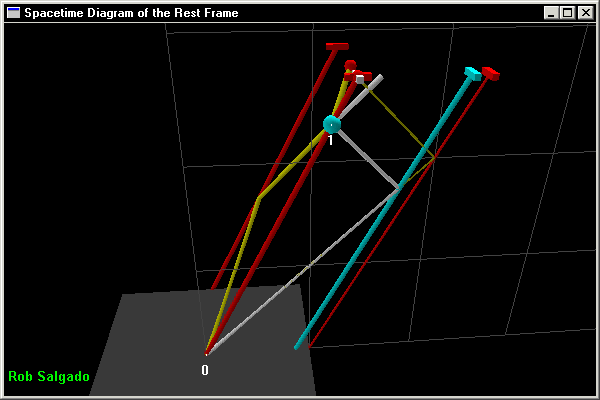
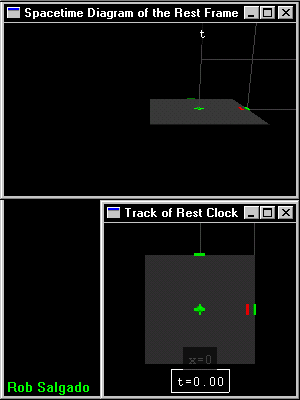
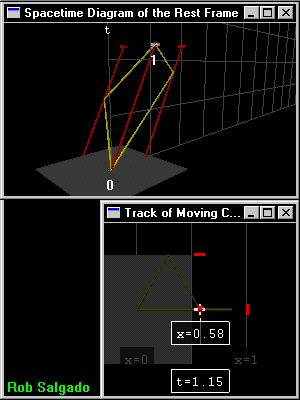
|
|
Here are the two cases side-by-side.
|
with contraction
- agrees with experiment
- in accordance with the Principle of Relativity
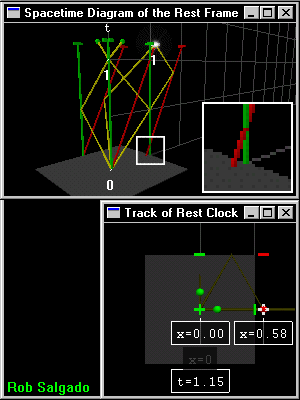
|
without contraction
- disagrees with experiment
- in conflict with the Principle of Relativity
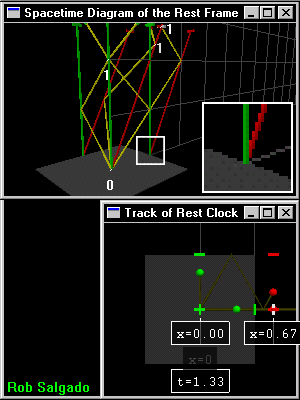
|
|
Absolute Simultaneity Lost
|
|
Observe that we regard
the "reflection events at our distant green mirrors"
to be simultaneous (i.e., they occur at the same value of
t for us).
However, observe that we do not regard
the "reflection events at his distant red mirrors"
to be simultaneous (i.e., they do not occur at the same value of
t for us).
In accordance with the Principle of Relativity,
he regards
the "reflection events at his distant red mirrors"
to be simultaneous (i.e., they occur at the same value of
[call it] t' for him).
The next visualization will elaborate on this.
|
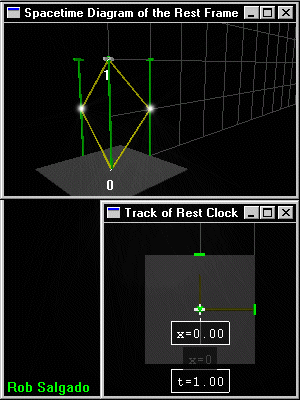
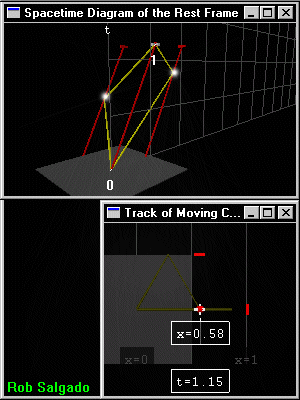
|
Circular Light Clocks
(Visualizing Proper Time) |
|
Let us generalize this to a circular arrangement of light clocks.
This provides us with a visualization of one tick of proper time.
Since each mirror traces out its worldline,
the collection of mirrors traces out a "worldtube".
Consider the light-cone of the first light-flash
and the worldtube of the green light-clock, which is at rest.
The intersection of that light-cone and the green worldtube
represents a set of "reflection events for the green light-clock".
These events are "simultaneous for the green light-clock".
Observe that these reflection events actually trace out a circle
[for the green light-clock].
Consider the unique plane that contains this circle.
Realize that all events on this plane are
simultaneous [for the green light-clock].
One could call this the "t=0.5-plane [for the green light-clock]".
Following the reflected rays leads to the "first tick".
(By the way, these reflected rays trace out the "[past] light-cone of the reception event".)
Then, the procedure can be repeated for the other ticks.
Upon considering all of the ticks for this clock, one obtains a "family of parallel planes
of simultaneity, marking the "half-ticks" [for the green light-clock]".
The same procedure applies to the
red light-clock, which is in motion.
The intersection of that first light-cone and the red worldtube
represents a set of "reflection events for the red light-clock".
These events are "simultaneous for the
red light-clock but NOT for the
green light-clock".
After tracing out the paths of all of these light-rays,
the measurement of the intervals of proper-time is now reduced to
the "counting of the ticks".
|
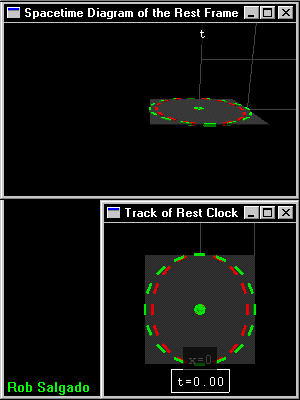
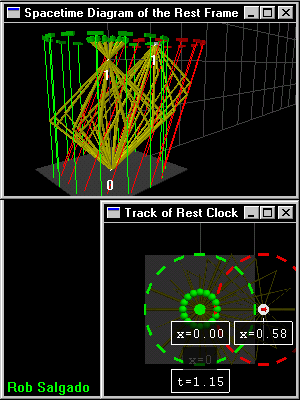
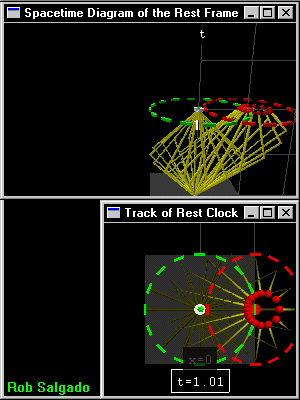
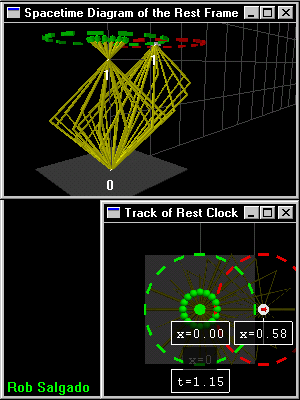
|
|
In order to work with simple arithmetic,
we will use a circular light clock with v=0.8c.
By counting ticks, it is evident that,
for the green light-clock,
"when 3 red-ticks have elapsed,
5 green ticks have elapsed".
The ratio 5/3 is the time-dilation factor
g = (1 - (v/c)2)-(1/2),
which you are invited to check.
|
There are a few other neat things [like the Doppler effect, the measurement of lengths, and
the symmetry of the observers] that one can "read off" such diagrams.
When I have some more time, I will update this page. For now, you
can have a look at my paper below.
|
|
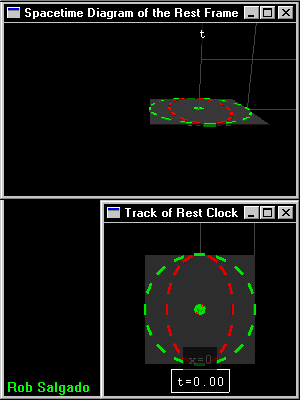
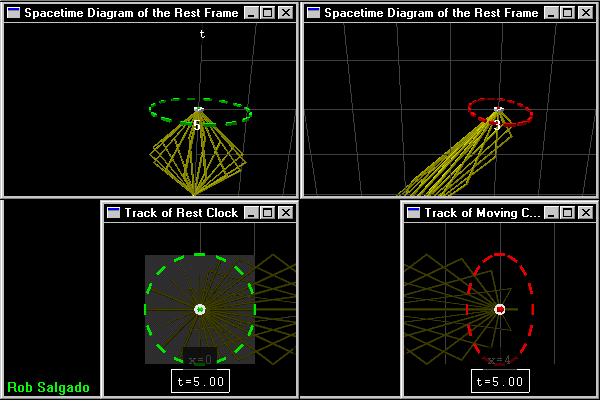
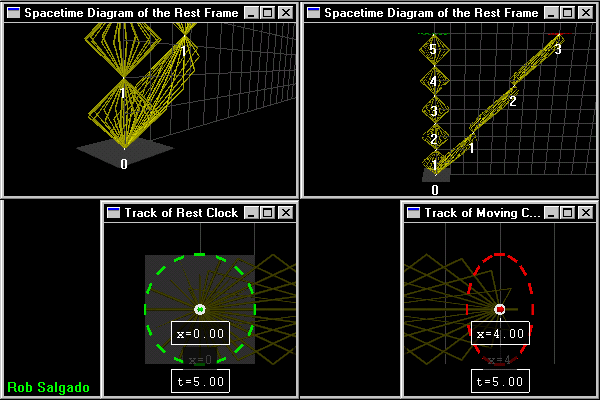
|
The Clock Effect / Twin Paradox |
|
Here is the Clock Effect/Twin Paradox.
Here's how the story runs (adapted from Spacetime Physics, ex. 27):
On their twenty-first birthday,
Peter
leaves his twin
Paul
behind on earth
and goes off in the x-direction for
(3 years) of his time at v=(0.8c),
then reverses direction and in another
(3 years) of his time
returns at the same speed.
- What is Peter's age at the moment of reunion?
- What is Paul's age at the moment of reunion?
The use of "twins" was just to make the story sound more dramatic.
Here is a less-dramatic formulation:
You and I meet. We synchronize our watches, and agree
to meet up later (here or at some other designated location).
When we meet that second time, we will find that our watches
are no longer synchronized.
(The issue of the [false] "paradox" arises when
one attempts to assert the brothers are "equivalent",
so that, by the supposed symmetry,
the age difference must be zero
[which is at odds with the notion of time-dilation].
The paradox is resolved when it is realized that
the brothers are, in fact, not-equivalent.
Paul has been an inertial observer
(traveling with a constant velocity-vector ["zero", in this case]) between
the separation and reunion events.
Peter, however,
has not been an inertial observer---he
has been for most of his trip. However, he changed his
velocity-vector when he turned around. That event
disqualified him from being "inertial".)
|
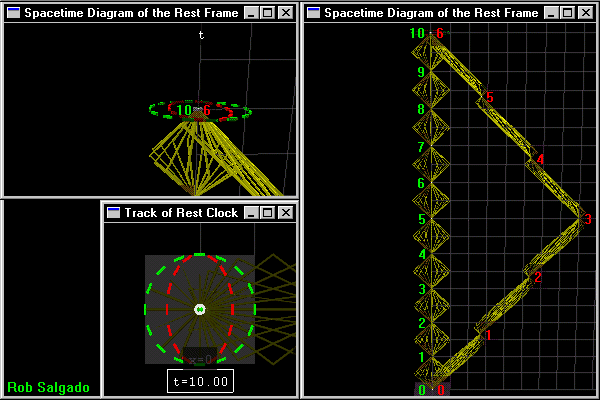
|
|
Let us draw a pretty picture (a Spacetime Diagram)
of the Clock Effect/Twin Paradox
using light cones.
|
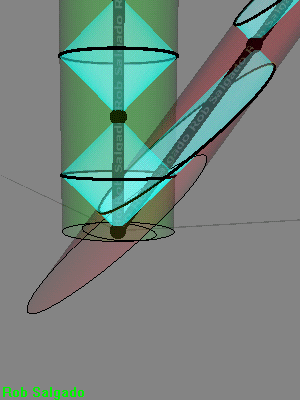

|
Visualizing Proper Time (the paper)
Details of this work (along with references) can be found in
Visualizing Proper Time in Special Relativity (Salgado) (PDF)
AAPT Summer 2001 meeting (Rochester, NY - July 25, 2001)
A slightly-revised version appears in
Physics Teacher (Indian Physical Society), v46 (4), pp. 132-143 (October-December 2004).
It is also posted at the
arXiv.org e-Print archive:
http://arxiv.org/abs/physics/0505134
.
Slides from my
AAPT 2004 Winter Meeting talk.
Slides from my AAPT 2005 Winter Meeting talk will be posted here.
|
Other sites of interest
(1997) The Light Cone - an illuminating introduction to Relativity
-- local copy: http://visualrelativity.com/LIGHTCONE/
(2006) The VRML Gallery of Electromagnetism
-- local copy: http://www.visualrelativity.com/vrml/electromagnetism/
VPython applications for Teaching Physics
-- local copy: http://visualrelativity.com/vpython/
other selected presentations
visualrelativity.com
|






























